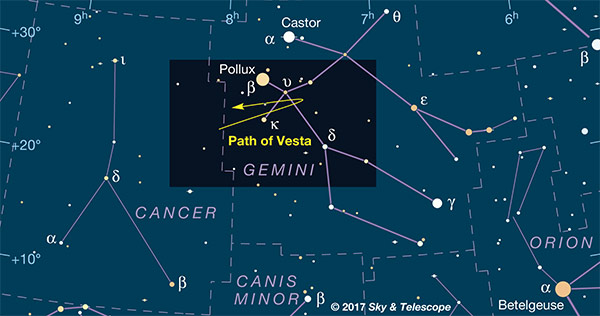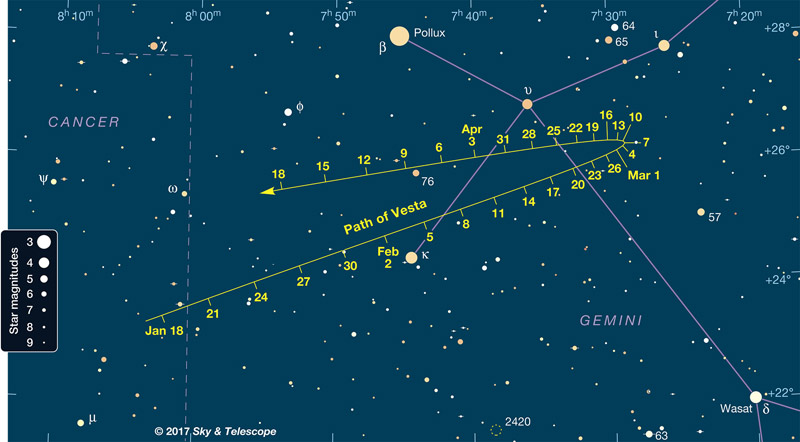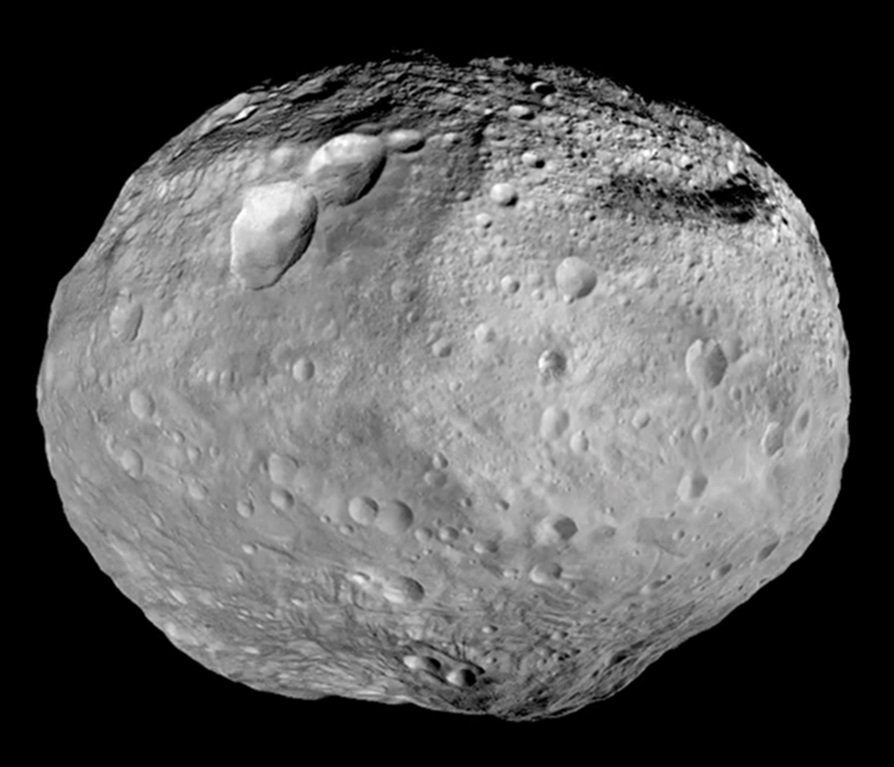Vesta is at opposition, shining at 6th magnitude in Gemini as it awaits your binoculars or small scope.
The first asteroid discovered, 1 Ceres, is still the biggest. But it's not the brightest. That honor goes to 4 Vesta, at least during the weeks around its times of opposition. Which means now.

This week Vesta shines an an inviting magnitude 6.2. It's conveniently located near Gemini's Pollux and Castor, which climb high up the eastern sky as evening grows late. Small binoculars will do the trick, if you have the charts here and know how to use them.
The chart above shows the whole Gemini constellation. Gemini is located left of Orion after dinnertime, and upper left of Orion as the evening draws toward midnight. The black box shows the area of the second, closer-up chart below.

Here Vesta's position is marked with a tick at 0:00 Universal Time every three days. For North America, this time falls in the early evening (or late afternoon) or the previous date. Put a pencil dot on Vesta's position for the evening when you'll go looking.
Click for a black-on-white version to print and take with you out into the night.
Outdoors, your starting point is Pollux. Note the pattern of the brightest stars around it. The closeup chart is 9° tall, nearly a fist-width at arm's lengths when you're viewing with the naked eye. In binoculars or a finderscope you see a somewhat smaller view, typically 5° or 6° tall. Bear this in mind when comparing.
North on the chart is up; north in the sky is always the direction toward Polaris. Turn the chart around to match.
Now, comparing the chart to your magnified view, use patterns of stars — triangles, rectangles, kite shapes — to work your way from Pollux to the asteroid's position.
At 6th magnitude, Vesta is fainter than the stars connected with purple lines to form the Gemini stick figure, but it's not nearly as faint as the tiniest stars shown. See the magnitude scale on the left.
In the coming weeks and months Vesta will fade into the distance, and you'll need more of those fainter stars. It will still be magnitude 6.5 on February 1st but 7.0 on March 1st and 7.6 on April 1st.
Vesta is one of the few asteroids that's been visited by a spacecraft. As seen in the image below from NASA's Dawn mission, it's a heavily cratered, somewhat oblong body of a lighter gray shade than most asteroids, which tend toward very dark brown or almost black. Explore in more detail, and reflect on the fact that this is the same tiny point you can locate yourself over your roof or treetops.

 4
4









Comments
@lennel
January 18, 2017 at 6:46 pm
I remember observing 4 Vesta asteroid back on Dec 2, 2016 last year when it was passing near the Beehive star cluster M44.
You must be logged in to post a comment.
@lennel
January 18, 2017 at 6:49 pm
From that time 4 Vesta was near M44 of Cancer constellation.
You must be logged in to post a comment.
Anthony Barreiro
January 20, 2017 at 1:57 pm
Thanks Alan. I've been watching Vesta during breaks in the clouds and rain for the past couple of weeks, through handheld 8x42 binoculars from my light-polluted urban back yard. For a couple of weeks before my first certain observation on January 5, I was learning the star field. After I had seen Vesta a couple of times it became much easier to recognize which sixth magnitude "star" was actually "star-like", an "aster-oid."
You must be logged in to post a comment.
January 20, 2017 at 5:20 pm
My first observation of Vesta this season was made 10 min ago in a familar star field near the variable star of U gem:-)
You must be logged in to post a comment.
You must be logged in to post a comment.